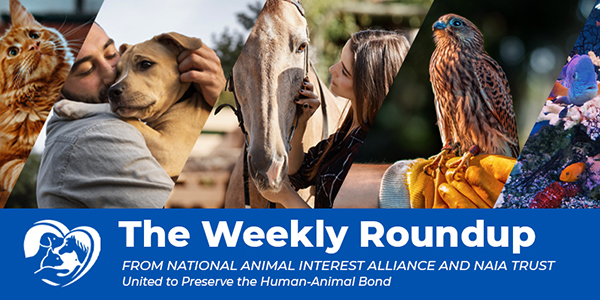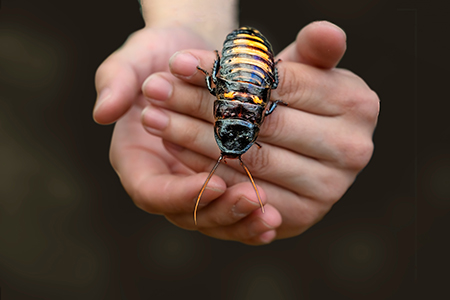
Inside This Issue:
- An Education on Exotic Animal Ownership at the Nebraska State Fair
- An Endangered Bird Is Just a Click Away...
- How Hurricane Katrina Changed Pet Evacuation Protocols
- News Bites: Animal Crimes, Please Drive Carefully, and More!
An Education on Exotic Animal Ownership at the Nebraska State Fair

Smile!
Wildlife Encounters, a mobile “edutainment” petting zoo run by Kip and Stacey Smith, brought some of their rescued exotic animals to the Nebraska State Fair to teach visitors about the realities of keeping such creatures as pets. Many of these animals were originally acquired by people who, for various reasons, severely underestimated the challenges involved in keeping a pet alligator. Admittedly, a seven inch baby alligator is adorable – we totally get why someone would want one, and why they might rationalize the choice. The idea of owning an adult alligator as a pet no doubt appeals to some people, too, for reasons we're not going to speculate about. But there are several reasons these animals are illegal or require special permits to own in much of the United States. Any animal that can grow to be more than 12 feet long and half a ton of pure muscle is going to cause problems when raised by someone who doesn't know what they're doing. That's just math. Add in the fact that these guys require specialized care for their entire lives – which can be up to five decades or more – and that alligators are wild animals with a bone-crushingly strong bite, and you have a recipe for poor pet ownership outcomes as well as unexpected public safety concerns.
So Wildlife Encounters has turned its rescue work into a traveling educational exhibit, visiting schools and events around the state to debunk myths and give honest answers about exotic animals in the wild and in human care. Their goal is to clear up common misconceptions and provide accurate information, since much of what people think they know comes from unreliable sources. Letting people see these animals up close has a lasting impact, changing how they view creatures that are often misunderstood or feared. This kind of direct experience encourages a deeper appreciation for wildlife and sparks a passion for conservation, especially in children. By making these connections, Wildlife Encounters hopes to inspire a new generation to care for and protect the animals that need our help. This is why their presentation at events like the Nebraska State Fair is so important: this isn’t just preaching to experts and the converted, it’s an opportunity to reach a large audience that may not be aware of the realities of exotic pet ownership and the importance of conservation.
Source: Wildlife Encounters encourages animal education at Nebraska State Fair
An Endangered Bird Is Just a Click Away...

Bali starlings/myna (Leucopsar rothschildicurious) – beautiful birds, and fewer than 50 of them are believed to still live in the wild.
Spain sits at the crossroads of Europe, Africa, and Latin America, and that geography has turned it into a key player in the global wildlife trafficking trade. Criminal networks routinely use the country as both a gateway and a stopover for moving illegal pets and animal products. The problem has only gotten worse in recent years thanks to weak enforcement, light penalties, and the rise of online marketplaces, which make it easy to buy and sell everything from exotic birds to endangered reptiles with just a few clicks.
One recent incident highlights this issue, showing just how bold traffickers can be. Spanish police uncovered an illegal pet shop operating in Nules, Valencia, after rare and exotic animals were openly advertised online. Inside, officers found more than 150 animals, including zebras, ring-tailed lemurs, and a critically endangered Bali starling. These species aren’t just illegal to own, many are also protected under international agreements like CITES. The total value of the seized animals came to nearly $81,500. Some of these creatures were protected under international law, and a few had even been reported stolen from elsewhere. The two men running the operation now face prosecution for trafficking and smuggling protected wildlife.
Cases like this highlight the scale and audacity of the illegal wildlife trade in Spain and the world over. While authorities are making progress, there is still big money to be made in trafficking, and a lot of people are getting away with it. The fight against trafficking continues globally with the Internet and organized crime making it a tough battle to win.
How Hurricane Katrina Changed Pet Evacuation Protocols

Hurricane Katrina
Has it really been two decades since Hurricane Katrina? The horrible images of the disaster are still crystal clear to anybody who lived through it. This NPR retrospective talks about the terrible chaos that followed that hurricane – especially in regards to pets – and how our views and policies toward pets in disasters and evacuations have changed since Katrina.
Many thousands of pets were left behind in the aftermath of Katrina. Rescue workers did not allow people to bring their pets, and there were numerous evacuation centers that didn’t allow pets. Some evacuees left food and water out for their pets, operating under an assumption that they would return in several days or a week, too – rather than months, years, or never. But many people, upon learning that rescue workers would not allow them to take their pets, simply chose to stay behind. Up to 200,000 people refused to evacuate, and according to this survey, 44% of them chose to stay, at least in part, because they didn’t want to leave their pets behind. This refusal to evacuate, along with all the abandoned pets, people sneaking back into the disaster area to retrieve their pets, and the fallout of mixing random rescued animals together created a humane, public health and safety, and logistical nightmare.
After Katrina, it was acknowledged that the emergency protocols in place were not equipped for 21st century disasters. The Pets Evacuation and Transportation Standards (PETS) Act was passed in 2006, to “address the needs of individuals with household pets and service animals prior to, during, and following a major disaster or emergency.” – which basically authorizes FEMA to help rescue and provide shelter to animals during and after emergencies. The new normal (and it does seem pretty normal) is for individuals to include their service animals and pets in evacuation plans and for disaster relief efforts to accommodate said animals whenever possible. This is a change in emergency policy that not only helps save pets, but it helps keep evacuation and relief efforts more orderly, and unquestionably keeps people alive, too.
Source: A lesson learned after pets were left behind in Hurricane Katrina: Save the animals
News Bites:Animal Crimes, Please Drive Carefully, and More!

Soon to be the only critter you can legally buy in an Easton, PA pet store?
Just last week, we posted about the slippery slope of pet store bans, and how they’re not about getting rid of bad individual breeders (which would be helpful and good), but rather, eliminating all deliberately bred, non-rescue animals in pet stores – regardless of the quality of care the animals receive (which is counterproductive and bad). It starts with dogs and cats, then moves onto other popular small animals, and eventually ends with banning the sale of, well, pretty much every pet – even goldfish, unless it is framed as an adoption. And, here, almost on cue, is Easton, Pennsylvania, talking about expanding its pet store ban from dogs and cats to everything except insects. (Maybe they forgot about invertebrates?) They want to “encourage owners to transition to a humane model” which basically means partnering exclusively with local rescues and shelters. Of course, if a pet store wants to partner with rescues and shelters and hold adoption events, that’s totally great – it’s the duplicitous and coercive nature of these ordinances that we have a problem with.
Pet cremation fraud is a rather niche crime that we’ve touched on a few times. It’s not as immediate and horrific as some of the other animal crimes we’ve covered, but the pain it causes pet owners is deep and very real. This week, the owner of a Maryland pet crematory was arrested for dumping customers' dead pets and giving them fake ashes. His wife faces charges, too. Blech.
Julia Ballard, A 92-year-old woman in Venice, Florida, is recovering after being assaulted by a group of women who stole three of her dogs. Mrs. Ballard says they asked to buy one of her dogs, but wouldn’t take no for an answer when she said the dog wasn’t for sale. The women then grabbed three of Mrs. Ballard’s dogs, and left the feisty nonagenarian covered in bruises for having the audacity to try and protect her dogs.
Sarasota County Sheriff’s deputies are actively investigating, using partial license plate information provided by a witness. Ballard is back home after a hospital visit but remains shaken and worried about her dogs. This case isn’t isolated. In recent years, the high demand for purebred and “designer breed” dogs has led to criminals robbing and even murdering for these prized dogs.
Are we becoming some kind of animal crime police blotter? No, but up ahead here are two cases that demonstrate an important phenomenon: when there is a crime involving animals, quite often, there are other criminal offenses or behaviors going on, as well.
First, in Roseburg, Oregon, a dog breeder was arrested for animal neglect last week and had 16 dogs removed from his property. We aren’t sure what type of dogs were on the property, but given that the police arrived due to a complaint about dogs fighting, it raises some questions about the operation. More related to the issue at hand: the breeder didn’t just have dogs seized from his property, police also discovered firearms and ammo, so along with neglect charges, the owner also faces firearms-related charges.
Second, a Sarasota, Florida dog groomer who was accused of beating on and generally mistreating the animals in her care pled no contest and received five years of probation, during which time she will not be allowed to own or control dogs, or groom animals. But the crimes the woman pled no contest to weren’t even why police were investigating her! This all started out as an investigation into financial crimes (the dog groomer has a long record, including arrests for grand theft and domestic violence), but the video evidence police collected, along with reports from staff and customers quickly transformed this into an animal abuse case.
Now for something more pleasant. Archaeologists in southeastern Turkey have uncovered tiny carved stone animals including a fox, a vulture, and a wild boar at the Karahantepe site, dating back roughly 11,500 years. These figurines, carefully arranged in a way that appears to tell a story, offer rare insight into prehistoric myth-making and the way early communities used art to share collective memories. The discovery is particularly notable because it shows that even the earliest artists gravitated toward animals as a central theme.
When you are driving down a road at 40 mph and an animal darts in front of your car, what’s the smartest thing to do? Well, according to this article, it depends on the animal and the road conditions. If you can’t break in time, the author says swerving for animals that stand lower than your hood is not worth the risk of losing control of your vehicle. However, for larger animals that can injure or even kill occupants by flying through your windshield, a swerve is worth the risk. That said, drivers who remain alert, aware of their surroundings, and obey speed limits have a significantly lower risk of playing the “to-swerve-or-not-to-swerve” game – this is great for avoiding vehicle damage and injuries, and several reliable sources tell us that animals really, really appreciate not being battered about by your 2.8 ton Silverado.
Also in the News...
★ Local artist creates mural to honor legacy of recently lost San Diego Zoo animals (Zoos; Inspiration from Sadness)
★ Rabid animals confirmed in half of SC counties this year. Here’s where, how to stay safe (Rabies on the Rise; Public Health & Safety)
★ Dozens of animals seized in El Paso animal cruelty case (Severe Neglect, Crowding, and Poor Conditions)
★ A (long) day in the life of a 4-H animal and its human (A Lot Goes in to Animal Husbandry)
★ Cincinnati Animal CARE unveils renovated shelter with improved space for animals (Shelter & Rescue Success Stories)
★ 5 Endangered Animals Fighting For Survival In Idaho (State Lists I: Endangered in Idaho)
★ Does Louisiana have a state animal? Learn about Louisiana's state animals here (State Lists II: Catahoula Leopard Dog Sighting)
Sign up for the 2025 NAIA Conference Today!
Click here to see what is happening legislatively


